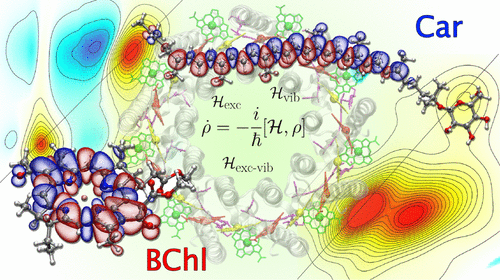当前位置:
X-MOL 学术
›
J. Am. Chem. Soc.
›
论文详情
Our official English website, www.x-mol.net, welcomes your feedback! (Note: you will need to create a separate account there.)
A Quantum Chemical Interpretation of Two-Dimensional Electronic Spectroscopy of Light-Harvesting Complexes
Journal of the American Chemical Society ( IF 15.0 ) Pub Date : 2017-05-17 00:00:00 , DOI: 10.1021/jacs.7b02130 Francesco Segatta 1, 2 , Lorenzo Cupellini 3 , Sandro Jurinovich 3 , Shaul Mukamel 4 , Maurizio Dapor 1 , Simone Taioli 1, 5 , Marco Garavelli 2 , Benedetta Mennucci 3
Journal of the American Chemical Society ( IF 15.0 ) Pub Date : 2017-05-17 00:00:00 , DOI: 10.1021/jacs.7b02130 Francesco Segatta 1, 2 , Lorenzo Cupellini 3 , Sandro Jurinovich 3 , Shaul Mukamel 4 , Maurizio Dapor 1 , Simone Taioli 1, 5 , Marco Garavelli 2 , Benedetta Mennucci 3
Affiliation

|
Nonlinear electronic spectroscopies represent one of the most powerful techniques to study complex multichromophoric architectures. For these systems, in fact, linear spectra are too congested to be used to disentangle the many coupled vibroelectronic processes that are activated. By using a 2D approach, instead, a clear picture can be achieved, but only when the recorded spectra are combined with a proper interpretative model. So far, this has been almost always achieved through parametrized exciton Hamiltonians that necessarily introduce biases and/or arbitrary assumptions. In this study, a first-principles approach is presented that combines accurate quantum chemical descriptions with state-of-the-art models for the environment through the use of atomistic and polarizable embeddings. Slow and fast bath dynamics, along with exciton transport between the pigments, are included. This approach is applied to the 2DES spectroscopy of the Light-Harvesting 2 (LH2) complex of purple bacteria. Simulations are extended over the entire visible-near-infrared spectral region to cover both carotenoid and bacteriochlorophyll signals. Our results provide an accurate description of excitonic properties and relaxation pathways, and give an unprecedented insight into the interpretation of the spectral signatures of the measured 2D signals.
中文翻译:

捕光配合物的二维电子光谱的量子化学解释。
非线性电子光谱学是研究复杂的多发色体系结构最强大的技术之一。实际上,对于这些系统,线性光谱过于拥挤,无法用于解开激活的许多耦合振动电子过程。相反,通过使用2D方法,可以获得清晰的图像,但前提是将记录的光谱与适当的解释模型结合使用。到目前为止,这几乎总是通过参数化激子哈密顿量来实现的,这些参数激子必定会引入偏差和/或任意假设。在这项研究中,提出了一种第一原理的方法,该方法通过使用原子和可极化嵌入将准确的量子化学描述与最新的环境模型相结合。快速和快速的浴动态,包括颜料之间的激子传输。此方法适用于紫色细菌的捕光2(LH2)配合物的2DES光谱。模拟扩展到整个可见-近红外光谱区域,以覆盖类胡萝卜素和细菌叶绿素信号。我们的结果提供了激子特性和弛豫途径的准确描述,并为解释测量的2D信号的频谱特征提供了前所未有的见识。
更新日期:2017-05-26
中文翻译:

捕光配合物的二维电子光谱的量子化学解释。
非线性电子光谱学是研究复杂的多发色体系结构最强大的技术之一。实际上,对于这些系统,线性光谱过于拥挤,无法用于解开激活的许多耦合振动电子过程。相反,通过使用2D方法,可以获得清晰的图像,但前提是将记录的光谱与适当的解释模型结合使用。到目前为止,这几乎总是通过参数化激子哈密顿量来实现的,这些参数激子必定会引入偏差和/或任意假设。在这项研究中,提出了一种第一原理的方法,该方法通过使用原子和可极化嵌入将准确的量子化学描述与最新的环境模型相结合。快速和快速的浴动态,包括颜料之间的激子传输。此方法适用于紫色细菌的捕光2(LH2)配合物的2DES光谱。模拟扩展到整个可见-近红外光谱区域,以覆盖类胡萝卜素和细菌叶绿素信号。我们的结果提供了激子特性和弛豫途径的准确描述,并为解释测量的2D信号的频谱特征提供了前所未有的见识。



























 京公网安备 11010802027423号
京公网安备 11010802027423号